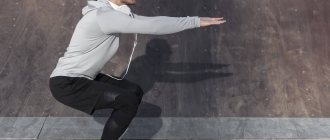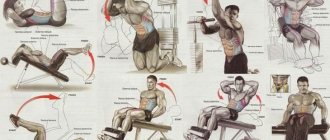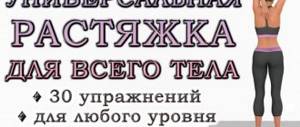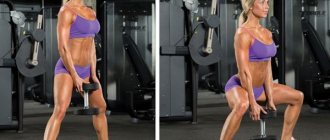Share: |
|
|
Functional training gives you every opportunity to get an attractive, physically developed body. The program helps increase mobility, flexibility, and helps prevent household injuries. The effectiveness of exercise does not depend on where you practice. Even alone, in an apartment you can achieve excellent results. This does not require complex equipment; simple devices are sufficient. The exercises are often performed with your own body weight.
The program includes exercises for different muscle groups, you can perform them to rhythmic music. Functional fitness is extremely diverse in terms of load range and selection of exercises. These include squats, deadlifts, push-ups, and pull-ups. Movements are performed in different planes. The system also includes various jumps, lunges, and planks.
Exercises are combined into several cycles to increase endurance. The classes are easy to diversify and complicate. To do this, use a horizontal bar and parallel bars, elements with a barbell, weights, and cardio equipment.
What are the benefits of functional training?
- The technique harmoniously develops physical qualities - strength, strength endurance, speed, mobility, coordination.
- Proportionally strengthens the muscles.
- Improves the proportions of the figure, forms a strong, athletically developed body - as a result of exercise, fat is burned and aesthetic muscles appear.
- Speeds up metabolism, improves health.
- During training, stabilizer muscles that are not involved in other areas of fitness are well loaded.
Functional training refers to those rare programs that work stabilizing muscles and specific muscle groups that are passive in everyday life. This effect is achieved due to the special biomechanics of multi-joint exercises.
Functional training for fast weight loss
The popularity of functional training is growing exponentially. They are accessible, intuitive, varied and effective. This discipline draws a parallel between sports and everyday life practices. With the types of physical efforts that we put in every day (bending, squatting, turning, etc.). These are basic actions and loads, which means you can handle them without difficulty!
The movements you make while cleaning, climbing stairs, playing with children or cooking are simple and natural. Could this mean that they cost us nothing? No! And such activity requires coordination, balance, flexibility and strength. Think about how you move through fresh snow or ice. In the first case, you need to raise your legs a little higher, in the second - balance.
Functional training is aimed at developing not only large and visible muscles, but also small stabilizer muscles.
Such muscles are located deeper and are the support for the body and the starting point of each process. Their pumping is not controlled at the psychological level. This means that you cannot concentrate on it (as in programs for large and visible muscles).
What sports qualities does functional training develop?
Bodyweight exercises improve strength:
- muscles become more developed, resilient and strong;
- different muscle groups work more harmoniously and economically, efficiency of movements is achieved;
- Stabilizing muscles are well developed and trained, as a result the musculoskeletal system is better protected from injury.
During training, speed and reaction indicators improve. The movements are performed using a high-speed, “explosive” technique. The heart, blood vessels, and respiratory system become resilient. Their safety margin and adaptive capabilities increase.
The “circular” or interval method has a positive effect on the body’s endurance and makes it easier to cope with any load. Favorable changes are also manifested in flexibility - joints and muscles become more elastic, and overall healthy mobility and mobility are achieved.
As a result of training, the athlete feels his own body perfectly, and his movements become coordinated. Balance appears, balance appears, posture improves.
Who is functional training suitable for?
The technique is not designed for any narrow group of athletes; it is suitable for everyone - teenagers, mature and elderly people. The level of basic training also does not matter; the training program can be easily customized to suit your needs, gradually increasing the number of approaches and the complexity of the exercises.
Functional fitness is suitable for those who:
- wants to become slimmer, get rid of excess weight;
- improve physical fitness, become athletic and fit;
- strengthen muscles and ligaments;
- develop endurance for a more active lifestyle.
With desire and perseverance, everyone achieves excellent results - both those who regularly train at home or at the stadium, and those who go to the gym or fitness center.
This is the optimal system that is recommended for anyone who wants to get a lean, athletic body. But to get massive muscles, it is better to choose bodybuilding or powerlifting.
Benefits of functional training:
- strengthens muscles, increases tone, makes the body slim, athletic, fit;
- reduces body volume and weight;
- increases flexibility, endurance, balance, balance;
- strengthens the heart, blood vessels and respiratory system;
- improves mood and vitality;
- you can study at home;
- various exercises do not get boring.
Who is this type of activity suitable for?
Functional training is a universal system for people of any age and level of training. You can exercise at home and in the gym. At home, you will be limited only by the lack of necessary equipment (rubber shock absorbers, unstable platforms, balls, body bars, dumbbells, etc.). Will this mean that you will not be able to achieve the desired effect? No! A lot of techniques have been developed that do not require any equipment at all.
These workouts are ideal for general physical fitness. They strengthen muscles, destroy fat reserves, develop endurance, and contribute to the acquisition of an athletic appearance.
Features of functional training in fitness
Each lesson in functional training is aimed at working all muscle groups. The load is divided into several circles (series), repeated one after another. Exercises follow one after another continuously, when the series is completed, you can rest.
The system is based on a number of principles:
- exercises are performed standing or resting on your hands;
- exercises with your own weight predominate in the training;
- The program includes multi-joint exercises;
- high-speed style of movements;
- the maximum number of muscles is worked out;
- gentle load on the spine, ligaments and joints;
- a “circular” approach is mainly used.
It is advisable to train 3 times a week and fully recover. The average ratio of aerobic and anaerobic load in this area of fitness is 30% to 70%. Much attention is paid to proper breathing and recovery. The break between classes should not be less than 1 day.
Features of functional exercises for women
Functional training is a universal tool for achieving sports goals (improving various areas, losing weight, achieving flat abs).
Specific features of such training include:
- Each muscle is considered here as an important element - that is why a sufficient number of isolation exercises are used (certain muscle groups are purposefully pumped).
- Increased intensity of exercise to increase the overall endurance of the whole body.
- The desire for proportional development of all muscles.
- A wide variety of auxiliary equipment: a variety of exercise equipment, sports balls, jump ropes, crossbars, barbells, weights, elastic bands, etc.
- The use of various exercises that are widely known in the sports world.
- It is possible to train not only in a specially equipped room, but also on the street, at home.
- It does not take much time - the duration of a standard lesson is from 40 to 60 minutes.
Note! The main rule of such training, which is true for women's and men's training, is the consistent inclusion of all muscle groups in the work.
Cons and contraindications
If your goal is to build muscle mass, this training will not work. It makes the body strong, muscular, toned, but functional training in fitness does not provide relief and volume, as in strength sports and bodybuilding.
The training is aimed at all muscle groups, this is the strong and at the same time weak side of the training. In the process of functional training, athletic qualities are harmoniously developed, but without phenomenal results in strength, flexibility, and other individual indicators and components.
Additionally, some bodyweight exercises require at least a minimum of basic physical fitness to perform.
There are also contraindications to functional training:
- diseases of the heart and blood vessels;
- diseases and injuries of the spine;
- disorders of the central nervous system;
- kidney problems;
- acute injuries, instability of the musculoskeletal system;
- infections, acute inflammatory process;
- exacerbation of a chronic disease;
- pregnancy.
Minor health problems are not a contraindication to exercise. Any exercise can be adapted to the state of the body and the level of training, simply by reducing the number of circles and repetitions, adjusting the duration of rest and simplifying the technique (for example, push-ups from a chair or from a wall).
Expert advice
I. Timko, sports expert, personal fitness trainer
I have a somewhat negative attitude towards writing training programs on my own - quite often beginners approach this matter too frivolously. But it is quite obvious that not everyone is able to pay for the services of a personal trainer. There are also those who fundamentally intend to draw up a lesson plan for themselves, or who simply do not have an intelligent instructor nearby.
On topic: Championship manager 03 04 no training
Anyone can write their own exercise plan if they have a little training experience. First of all, you should focus on performing the exercises correctly (choose only those whose technique you are familiar with). Also, do not forget about proper rest between classes - while adapting to stress, the body needs a balanced diet and quality sleep (at least 8 hours).
V. Mayorov, CMS in powerlifting, professional bodybuilding instructor
A functional training plan primarily prepares your body for various everyday stresses, activates muscles, increases endurance and overall flexibility. Such training should not cause pain or significant physical discomfort.
For optimal results, be sure to warm up all joints and ligaments before your next session - proper and sufficient warming up will help avoid possible injuries. If you have not trained before, I advise you to undergo a medical examination to check for any special contraindications.
R. Panov, instructor of the X-Fit fitness club, personal trainer
Exercises that are worked through during functional training help “harden” the body and improve overall well-being at any age. Also, to start training, your level of physical fitness is completely unimportant - muscle pumping will occur gradually (so that the body has time to adapt to new loads).
Beginners can train without any weights or additional equipment; increasing weight is only necessary for further progress. In a gym setting, you can also use TRX loops, chains, etc. The more varied your sports activity, the better for the final result.
Tips for beginners
Before you start exercising, determine your desired goals. Keep a training diary and write down what you want to achieve - reduce fat mass, build an athletic figure, become physically stronger and stronger.
Depending on the goals and starting capabilities, the instructor draws up a training program.
General rules for beginners:
- Gradually increase the load - volume, intensity and complexity of exercises.
- Strive for self-discipline - train regularly, record your loads.
- Monitor your diet and keep a diary. It is advisable to change the ratio of products in favor of protein. Limit the percentage of fast carbohydrates.
- Weigh yourself regularly.
- Strive to improve your level, compete first of all with yourself.
For beginners, circuit training consisting of exercises without weights is good. Gradually increase the speed and range of movements. If your goal is to lose weight, you must be in a calorie deficit, otherwise it will be difficult to achieve what you want. It is recommended to include cereals, meat, eggs, nuts, and vegetables in the diet.
Over time, for better results you will need sports nutrition - protein, creatine, vitamin complexes for muscle development, bone strength and ligaments.
Functional training is accessible to many, regardless of the initial level of training. The main thing for beginners is a normal level of health, the absence of serious contraindications and the choice of an adequate load.
Interval training for beginners
You may have already heard of interval training, a training method that forces you to step out of your comfort zone for a certain period of time and then recover. Interval training is so popular because training at higher intensity levels helps you build endurance faster and burn more calories, which is important for weight loss.
Instead of exercising at the same pace throughout your workout, you mix up different intensities, which makes the workout seem shorter than it actually is.
Necessary equipment
We've prepared an effective 21-minute cardio workout for beginners. Thanks to this program, you can prepare your body for serious stress. The workout is shown on treadmills with changes in speed and incline, but you can use any other machine or do the workout outside.
Options:
- Elliptical trainer
- Exercise bike
- Fast walk
- Run
- Riding a bike on the street
Simply use intervals to increase speed, incline, and/or resistance depending on what type of workout you're doing.
Instructions
High Intensity Sets: For each set, increase the intensity (speed, incline, etc.). If you're exercising outside, increase your speed or find an incline. You have to step out of your comfort zone, but not so much that you feel dizzy.
Recovery Sets: These sets involve decreasing the intensity to gradually return to a moderate pace. You should be fully recovered for the next intense set.
Vary the speed and intensity according to your fitness level: If you are not ready for higher intensity, it is wise to use an intensity that you are comfortable with.
The Rating of Perceived Exertion (RPE) scale helps you track intensity on a scale of 1 to 10. High-intensity sets are 5-6 RPE. Recovery sets – 4 to 5 RPE.
You can use the target heart rate calculator to monitor your exercise intensity.
How is the lesson going?
The training begins with a warm-up. Since functional exercises involve active movements, jumping, and strength exercises, you need to warm up the joints and muscles in advance, the body must be ready for complex amplitudes and explosive tempo. A good warm-up improves the effectiveness of movements and prevents injuries.
Any basic aerobic exercise is suitable as a warm-up - walking, jogging, jumping rope, cardio equipment. The duration of the lesson is from 30 minutes to 1 hour, depending on basic training and goals.
Class Rules
Although strength training can be called one of the safest types of training, no one has canceled the precautions. Consult your doctor before starting. Everything is fine? Then you can safely begin.
Basic rules of the training:
- Correctly distribute the ratio of cardio and strength training. If your goal is to get rid of extra pounds, then it is better to give preference to the 70/30 scheme at the initial stage. Where 70 is the percentage of aerobic exercise, and 30 is strength. Next, the ratio will need to be shifted, creating variability, that is, not allowing the body to get used to it. As soon as you feel that the exercise is easy, immediately complicate it. Our body is able to adapt to almost any conditions offered to it. Challenge yourself and you will be surprised at how resilient, flexible and dexterous your body has become.
- Choose a set of strength exercises so as to use the maximum number of muscles. Remember that it is better to divide strength exercises into more sets with fewer repetitions, but do them well and fairly.
- Don't overdo the scales. Many people mistakenly believe that the more they take on themselves, the faster they will reach their goal. Unfortunately, it is not. Weight should constantly increase, but gain should be minimal . If we are talking about exercise equipment, then it’s worth adding 5 every 10-20 days (depending on the frequency of training). For free weights, the increase may be an additional 500 grams, if we are talking about women's dumbbells. Overexertion and injury will not bring you any closer to your dream. Be reasonable.
- Remember to breathe. Many of us remember how the good old Soviet exercise ended: hands up - inhale, hands down - exhale. It is important to restore your breathing after exercise, but even more important is to control it throughout the entire exercise. Breathing takes an active part in all processes in the body. It regulates temperature, pressure, and helps to stretch properly. Control your breathing until it becomes automatically correct, that is, inhale for relaxation, exhale for effort.
- Remember the importance of recovery. More doesn't always mean better. You should not exercise several times a day. This will not bring the desired slimness, but will make the body sense danger and begin to accumulate fat (what if this is not training, but hard labor). Give your muscles 24 hours of rest and quality stretching.
Functional training for weight loss
The program is suitable for losing weight and speeding up metabolism. Functional fitness training promotes active fat burning; it is one of the most effective methods for increasing muscle mass and reducing fat percentage. Many calories are burned during and after high-tempo workouts involving different muscle groups. You can combine exercise with taking L-carnitine, a sports nutrition that stimulates fat burning.
To achieve sustainable weight loss, you need to exercise at least every other day. It is advisable to organize your diet properly and eat more protein foods. If you train irregularly and for less than 30 minutes, you should not expect sustainable results.
5 Healthy Benefits of Functional Training
- Such a workshop improves all fundamental physical qualities. This means that functional training develops flexibility and agility, strength and aerobic endurance, coordination and speed at the same time.
- Develops skeletal muscles. Harmoniously and balanced loads all muscle groups. Dynamically engages stabilizer muscles.
- Improves body appearance. Burns fat, builds beautiful “lean” muscles.
- Improves health and speeds up metabolism. Motivates you to get rid of bad habits and eat smarter.
- Expands the sports range. Such training involves a wide range of exercises and equipment used.
Such intense training helps burn calories. During prolonged exercise, accumulated fat acts as an energy source, which promotes fat burning. Another bonus is the increase in muscle mass, which makes the body more toned.
Is it possible to gain muscle mass through functional training?
The training is not initially intended to pump up muscles. The emphasis in this system is on overall body development rather than on the strength and mass of individual muscles. When choosing this method, you should not expect a noticeable increase in body volume and expressive athletic relief. However, there are ways to still achieve muscle gain:
- do more movements with weights (barbells, dumbbells, kettlebells) and strength exercises (pull-ups, push-ups, squats);
- the optimal number of repetitions per approach is 12-15;
- train twice a week or three, but working different muscle groups;
- Follow a high-protein diet and creatine to increase explosive strength and muscle size.
How to create a functional training program?
To achieve a well-rounded body, you need to use many training techniques. In addition to strength work, an auxiliary load is also needed.
By reducing the strength portion of your workouts to 40 minutes, you will recover better. You will grow and at the same time improve your functional qualities.
To become more functional, you need to exercise in all three planes. Also additionally train balance, mobility, turning ability and explosiveness. Spend the last 25 minutes of your workout doing functional exercises that work best for your body.
Focus one workout a week entirely on CrossFit. Work on your weaknesses in this workout.
Useful article: “3 Ways to Win at CrossFit Competitions”
Monitor recovery so that your muscles fully recover from microtrauma before your next strength or functional training session. Train hard, push yourself to the max, but remember that your progress largely depends on genetics, your body's response to stress and the effort you put in.
Equipment and clothing for training
Most of the exercises are performed with your own weight and improvised means, sometimes light dumbbells, barbells, and weights are added. You can exercise anywhere - in the gym, on the sports ground, in the yard, at home. If desired, you can diversify the exercises by adding special fitness equipment: expanders, cables, elastic loops. Ropes, fitballs, and jump rope can be used. The classic gymnastic horizontal bar, rings, and parallel bars are great for practicing. You can add cardio exercises (treadmill, exercise bike, rowing machine) to your circuit training.
Clothing should be comfortable and not restrict movement. This can be standard fitness equipment or special kits, for example, for CrossFit. Regular sportswear for functional fitness training - tights or shorts, a T-shirt, a sports top, comfortable sneakers made of elastic material with a stable sole.
Functional training – what is it and why is it needed?
Exercises with your own body weight are a tool for losing extra pounds, becoming stronger, faster, healthier. Functional training – what is it and how can you use it to develop athletic qualities?
We live in a world of functional movements and each of us is a physical organism. Training allows you to improve your physical capabilities and at the same time your appearance. In our country, the development of this direction was started by coaches A. Zhukov and A. Feoktistov. At first, training was used by professional figure skaters, speed skaters, sprinters, and discus throwers. Gradually, training and programs migrated to fitness rooms.
Functional training is those exercises that develop an array of functions and are performed in conjunction . The purpose of such fitness is to expand functions. Simply put, if you start from scratch, these will be simple push-ups. After strengthening this function, push-ups on the fingers follow, then with hands placed in front or behind. As a result, you can learn to do dozens of push-ups by developing the function.
Conclusions – why is it worth doing functional fitness?
Functional training promotes versatile sports progress - with each training session you gain strength, endurance, speed, and flexibility. Training is available to everyone, the system has a minimum of contraindications. It is easy to organize the training process at home. Classes do not take much time. Interval circuit training with minimal rest between sets allows you to work all muscle groups in 30-40 minutes.
Functional training can improve athletic fitness, reduce fat mass, and strengthen the heart and lungs. The result is visible after 1-2 months of regular training.
Workouts for women in the gym - important points
When drawing up a training plan in the gym, women need to take into account several characteristics of the body. What points need to be taken into account:
- A small number of muscles means that smaller muscle groups should receive less attention. Women's muscles have such a feature that the muscles are distributed unevenly throughout the body. Most often, the problem areas are the hip and gluteal groups - more exercises need to be allocated to them than to the upper part of the body. In other words: for the hips and buttocks, perform 3 different exercises, and for the rest of the body, 1 each. Keep in mind that it is necessary not only to perform strength training, but also aerobic exercises so that the muscles are small, but toned and developed.
- The period of ovulation - it must be taken into account in order to change the abdominal workout during this period of time (eliminate it altogether). During ovulation, women are not recommended to overload the body, so the amount of work needs to be reduced: perform no more than 3 approaches with three repetitions.
- The total volume of training is an equally important indicator, implying not only the time spent in the gym, but also the number of repetitions in total, and the time allotted for rest. Regarding repetitions, women are recommended to perform no more than 25 repetitions for each exercise. The optimal rest time between sets is 30-60 seconds. During the training process, be sure to drink water.











